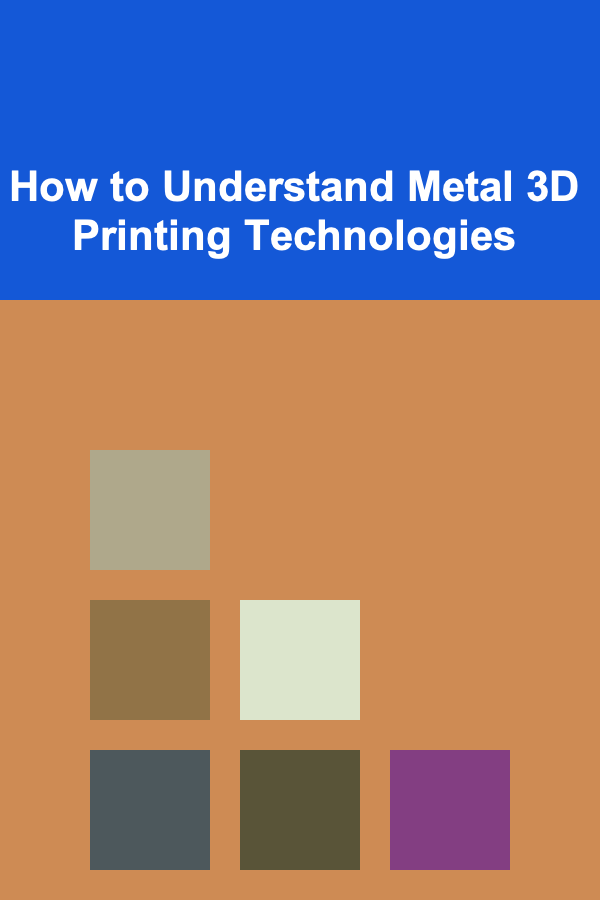
How to Understand Metal 3D Printing Technologies
ebook include PDF & Audio bundle (Micro Guide)
$12.99$10.99
Limited Time Offer! Order within the next:

Metal 3D printing, also known as additive manufacturing, has evolved significantly over the past decade. It is rapidly becoming a game-changer across industries such as aerospace, automotive, healthcare, and manufacturing. Unlike traditional subtractive manufacturing methods, which involve cutting away material to create a part, 3D printing builds objects layer by layer, which allows for the creation of highly complex geometries that would otherwise be impossible or very costly to produce. In the case of metal 3D printing, a wide range of metal alloys can be printed to create strong, durable, and functional parts.
This article aims to provide a comprehensive understanding of metal 3D printing technologies. We will cover the different types of metal 3D printing processes, the materials used, applications, advantages, challenges, and future trends in this revolutionary technology.
The Basics of Metal 3D Printing
Metal 3D printing is the process of creating metal parts using additive manufacturing techniques. The basic principle behind metal 3D printing is the same as that of plastic 3D printing, where the material is deposited in successive layers to build up a three-dimensional object. However, instead of plastic filament or resin, metal powders or wire are used in the printing process. The key difference is that the metal must be heated or melted to form a solid layer, which requires more advanced technology and precision.
The primary types of metal 3D printing methods are:
- Selective Laser Melting (SLM)
- Electron Beam Melting (EBM)
- Direct Metal Laser Sintering (DMLS)
- Binder Jetting
- Directed Energy Deposition (DED)
Each of these technologies has its own unique mechanisms for transforming raw metal material into a final product.
1. Selective Laser Melting (SLM)
Selective Laser Melting (SLM) is one of the most widely used methods in metal 3D printing. In this process, a high-powered laser is used to melt and fuse fine metal powder particles. The laser selectively melts the powder in a precise pattern to form each layer of the object. As the laser moves across the powder bed, it melts the powder at the point where it strikes the surface, and the molten metal solidifies as it cools. The process is repeated layer by layer until the entire part is completed.
SLM is ideal for creating parts with complex geometries and high mechanical properties. It is typically used for metals such as titanium, stainless steel, aluminum, and nickel alloys.
2. Electron Beam Melting (EBM)
Electron Beam Melting (EBM) operates on a similar principle to SLM, but instead of a laser, it uses an electron beam to melt the metal powder. The process takes place in a vacuum, which is beneficial for materials that require a controlled environment, such as titanium and its alloys. EBM is often used in industries where parts are exposed to extreme conditions, such as aerospace and medical implants.
The advantage of EBM over SLM is its ability to produce dense and strong parts, but the trade-off is slower production speeds. EBM is also limited in terms of the materials that can be used, with a primary focus on titanium and titanium alloys.
3. Direct Metal Laser Sintering (DMLS)
Direct Metal Laser Sintering (DMLS) is a metal 3D printing process similar to SLM but with slight differences in its application and material compatibility. DMLS uses a laser to sinter the metal powder---rather than fully melting it---causing the powder particles to fuse together. This process is highly effective for creating metal parts with excellent mechanical properties. DMLS is commonly used for producing metal parts for aerospace, automotive, and medical applications.
One of the key benefits of DMLS is the variety of metal alloys that can be used, including stainless steel, cobalt-chromium, and aluminum. DMLS is also particularly advantageous for producing small-batch, high-performance parts.
4. Binder Jetting
Binder Jetting is a metal 3D printing process in which a liquid binder is selectively sprayed onto a bed of metal powder to form a solid layer. Once a layer is complete, the powder bed is moved down, and the next layer is printed. After the printing process is completed, the green part (a part that is not yet fully sintered) is subjected to a sintering process in a furnace to fuse the metal particles together into a solid object.
This technology is often used for producing metal prototypes or parts for industries like aerospace and automotive, where complex parts need to be produced quickly and cost-effectively. Binder Jetting can also handle a wide range of materials, including stainless steel, aluminum, and copper.
5. Directed Energy Deposition (DED)
Directed Energy Deposition (DED) is a metal 3D printing process that involves the deposition of metal powder or wire onto a substrate while a laser, electron beam, or plasma arc melts the material as it is deposited. DED is often used for repairing or adding features to existing metal parts, making it ideal for industries like aerospace and defense.
The main advantage of DED is its ability to add material directly to existing parts, which makes it useful for part repair or modification. However, the process typically requires higher precision compared to other methods.
Materials Used in Metal 3D Printing
Metal 3D printing offers a wide variety of materials to choose from, depending on the desired properties of the final product. The most common materials used in metal 3D printing include:
- Stainless Steel: Stainless steel alloys are the most commonly used metals in 3D printing, offering a good balance between strength, corrosion resistance, and ease of processing. They are ideal for applications in automotive, aerospace, and medical industries.
- Titanium Alloys: Titanium is known for its strength-to-weight ratio and is widely used in aerospace, medical, and automotive applications. Titanium alloys like Ti6Al4V are commonly used in metal 3D printing.
- Aluminum Alloys: Aluminum is lightweight, corrosion-resistant, and has good thermal and electrical conductivity, making it an ideal choice for automotive, aerospace, and electronics industries.
- Nickel Alloys: Nickel alloys such as Inconel are commonly used in high-temperature applications like gas turbines and jet engines.
- Cobalt-Chromium Alloys: These alloys are frequently used in the medical field, particularly in the production of prosthetics and dental implants.
- Copper: Copper and its alloys are ideal for applications requiring high thermal conductivity, such as heat exchangers and electrical components.
The wide variety of materials available for metal 3D printing allows manufacturers to choose the best material for their specific application, ensuring parts have the necessary strength, durability, and resistance to environmental factors.
Applications of Metal 3D Printing
Metal 3D printing has found applications across various industries due to its ability to create complex geometries, reduce material waste, and enable rapid prototyping. Some of the key industries using metal 3D printing include:
Aerospace
Aerospace manufacturers use metal 3D printing to produce lightweight, complex, and high-performance parts. This includes components for engines, airframes, and other critical systems. Metal 3D printing enables the production of parts with intricate internal structures, reducing weight while maintaining strength. Additionally, the ability to produce parts on-demand has reduced the need for expensive molds and tooling.
Automotive
In the automotive industry, metal 3D printing is used for producing both functional prototypes and end-use parts. It allows for the design of parts with complex geometries that would be difficult or impossible to create using traditional manufacturing methods. Furthermore, the ability to produce small batches of customized parts has been beneficial in creating bespoke vehicles or modifying existing ones.
Healthcare
Metal 3D printing has revolutionized the healthcare industry by enabling the creation of customized medical devices, implants, and prosthetics. One of the most significant applications is in the creation of titanium implants for bone replacements, as the material is biocompatible and strong. 3D printing allows for precise customization to fit individual patients' needs, improving the outcome of surgeries and reducing recovery times.
Tooling and Manufacturing
Metal 3D printing is increasingly used in tooling and manufacturing to produce jigs, fixtures, and other custom tools. It can reduce the time and cost involved in creating tools, while also allowing for the production of tools with complex geometries that are otherwise impossible to create using traditional methods. This leads to improved efficiency in manufacturing operations.
Advantages of Metal 3D Printing
Metal 3D printing offers several advantages over traditional manufacturing methods, making it an attractive option for many industries:
- Complex Geometries: Metal 3D printing allows for the creation of highly intricate parts and geometries that are not possible with conventional manufacturing techniques. This is particularly useful in industries like aerospace and healthcare, where complex designs are required.
- Reduced Material Waste: Unlike traditional subtractive manufacturing methods, which remove material to create a part, metal 3D printing only uses the material needed, significantly reducing waste.
- Customization: 3D printing allows for the easy production of customized parts and components, which is especially useful in applications like medical implants and automotive manufacturing.
- Rapid Prototyping: Metal 3D printing allows manufacturers to create functional prototypes quickly, enabling faster product development cycles and iteration.
- Tooling Elimination: Metal 3D printing removes the need for costly molds, dies, and tooling, reducing upfront costs and lead times.
Challenges of Metal 3D Printing
While metal 3D printing offers numerous benefits, there are also several challenges to consider:
- Material Limitations: Although the number of metals available for 3D printing is increasing, the variety of materials is still more limited compared to traditional manufacturing methods.
- Cost: Metal 3D printing equipment and materials can be expensive, making it less viable for low-volume production. However, prices are expected to decrease as the technology matures.
- Post-Processing: Many metal 3D printed parts require post-processing, such as heat treatment, surface finishing, and support removal, which can add time and cost to the production process.
- Quality Control: Ensuring the quality and consistency of 3D printed metal parts can be challenging, especially for critical applications like aerospace or medical implants.
The Future of Metal 3D Printing
The future of metal 3D printing looks promising, with ongoing advancements in materials, technology, and applications. As new alloys are developed and printing speeds increase, we can expect metal 3D printing to become more widespread and accessible. Furthermore, improvements in software and automation will make it easier for manufacturers to optimize their 3D printing processes, reducing costs and improving the quality of parts.
The potential applications of metal 3D printing are vast, and we are likely to see new use cases emerge as industries continue to explore its capabilities. From creating lightweight components for space exploration to customized medical implants that improve patient outcomes, metal 3D printing is poised to play a significant role in shaping the future of manufacturing.
Conclusion
Metal 3D printing is an exciting and transformative technology that has already begun to revolutionize industries ranging from aerospace to healthcare. By understanding the different types of metal 3D printing processes, materials, applications, and challenges, we can better appreciate the potential of this technology. As advancements continue to be made, metal 3D printing will likely become a staple in modern manufacturing, offering new opportunities for innovation and efficiency.
The future of metal 3D printing is bright, and it will undoubtedly continue to reshape the way products are designed, produced, and distributed across the globe.

How to Build a Checklist for Social Media Event Promotion
Read More
How to Create a Garden Shed Organization System
Read More
How to Make the Most of Under-Sink Storage
Read More
How to Prevent Car Break-ins in Your Driveway
Read More
How to Stage Your Home for the Holidays to Attract Buyers
Read MoreBudget Tracking for College Students: A Complete Guide
Read MoreOther Products

How to Build a Checklist for Social Media Event Promotion
Read More
How to Create a Garden Shed Organization System
Read More
How to Make the Most of Under-Sink Storage
Read More
How to Prevent Car Break-ins in Your Driveway
Read More